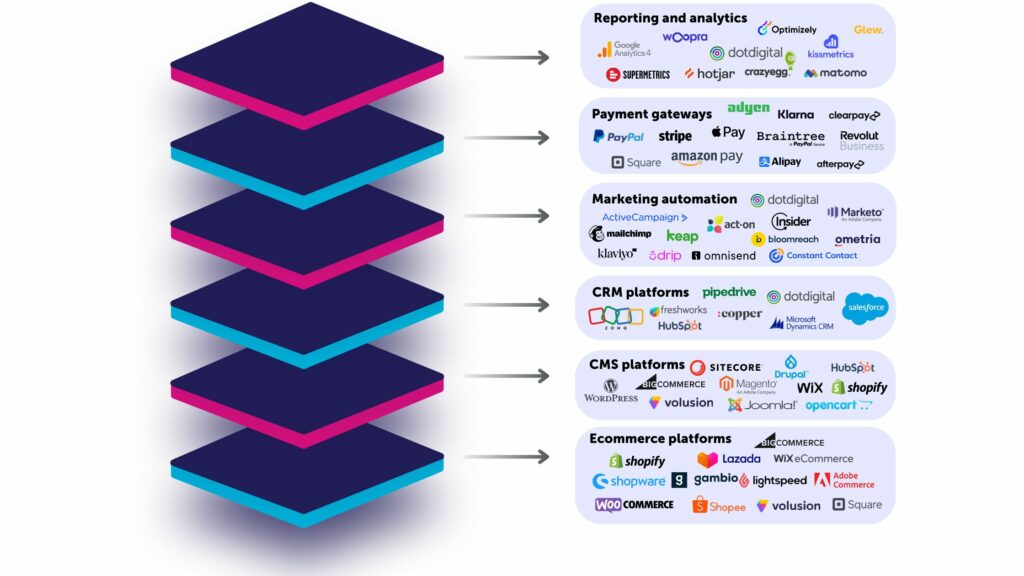How to build the perfect ecommerce tech stack in 2024

In 2008, Gartner reported that worldwide SaaS (software as a service) revenue reached $6.4 billion. In 2024, SaaS spending is predicted to reach $243.9 billion.
This perfectly encapsulates the struggles facing marketing and IT teams in recent years. The capabilities of software, tech, and apps have streamlined and enhanced business ambitions. For ecommerce brands, it has facilitated success like we’ve never seen before. From payment gateway systems with global reach to advanced personalization tools, ecommerce brands have developed a prolific tech stack to reach their goals.
But, after this period of unprecedented technological growth, we’re finally beginning to enter an era of stabilization. This doesn’t mean no more growth. In fact, it’s the complete opposite.
Tech stacks are sprawling. According to Zylo’s SaaS Management Index, the average size of a tech portfolio is 269 separate applications. Efficient management of tech stacks is essential. Reducing sprawl, streamlining apps, and strengthening governance will cut costs, drive efficiency, and give you more budget to reinvest in innovation.
What is an ecommerce tech stack?
An ecommerce technology stack (or tech stack) is a collection of software tools or applications that support the development of your online retail store.
A strong and efficient tech stack is the foundation of any successful ecommerce business. Together, these technologies power your website, manage operations, and deliver exceptional customer experiences.
Think of it as a puzzle. Each piece—from your ecommerce platform to your payment gateway—interconnects to create a seamless shopping journey. Your tech stack encompasses everything from the visible front-end design to the behind-the-scenes systems that handle orders, inventory, and customer data.
Ecommerce tech stacks typically have three key aspects:
1. The front-end (customer-facing): These are the building blocks of your user interface (UI) that customers interact with directly. Think:
- HTML
- CSS
- JavaScript
They determine the look, feel, and functionality of your ecommerce store.
2. The back-end (server-facing): These applications handle the behind-the-scenes operations that power your online store. Think:
- Ecommerce platforms
- Programming languages
- Servers
- Databases
They ensure smooth functioning, data storage, and secure transactions.
3. Other components: These are your essential tools that integrate with your front-end and back-end to provide specific functionalities. Think:
- Payment gateways
- Inventory management systems
- Content management systems
- Fulfillment and shipping software
- Customer service and support technology
- Returns management software
They are typically chosen to suit the specific needs and requirements of your business.
What is a perfect ecommerce tech stack?
There’s no one-size-fits-all solution when it comes to building an ecommerce tech stack. Your store is unique, and so too is the ideal combination of software and platforms needed to power your online operations.
A perfect tech stack is a carefully curated collection of tools that seamlessly align with your specific goals, target audience, and business model. It’s a dynamic ecosystem that evolves as your business grows and customer expectations change.
One thing that is certain though, is that cost-efficiency, reduction of applications, streamlining workflows, and customer experience are essential.
The core pillars of an ecommerce tech stack
We’ve already covered the key aspects of a tech stack, but let’s have a look at the core pillars marketers need to build an effective and efficient ecommerce tech stack.
1. Ecommerce platform
Naturally, your ecommerce platform should be the cornerstone of your tech stack. When choosing your platform, you need to put your growth ambitions front and center. A platform that can scale with you is essential. Whether you’re a small start-up or a well-established enterprise, your ecommerce platform should accommodate your increasing sales, product range, and customer base.
You also need to consider your platform’s ability to handle spikes in traffic during peak sale seasons (like Black Friday and Cyber Monday). Integrations with other tools are also a huge factor for streamlined workflows. Shopify, BigCommerce, Adobe Commerce, and Shopware are big players in the industry, meaning their integration capabilities are high.
You must evaluate your specific needs before making your decision.
2. Content management system (CMS)
Your content management system (CMS) is the backbone of your website. It allows you to create, edit, and manage your online content without needing extensive technical knowledge.
For ecommerce marketers, this means you can easily update product descriptions, images, pricing, and inventory levels, keeping your store up-to-date and ensuring a superior customer experience (CX).
A CMS should also allow you to create engaging editorial content in the form of blog articles, informative landing pages, and compelling website copy. This flexibility is crucial for search engine optimization (SEO), developing seamless marketing campaigns, and building customer trust.
Popular CMS options like WordPress and Drupal are favored for their user-friendly interfaces and the vast array of plugins and themes. For those ecommerce marketers seeking ultimate flexibility and performance, a headless CMS may be the solution. These decouple the content management back-end from the visual front-end, providing developers with greater control over the user experience.
By evaluating your needs and choosing the right CMS, you can streamline your content creation process, and improve web performance. Ultimately, this will allow you to deliver a better overall CX.
3. Customer relationship management (CRM)
A customer relationship management (CRM) system is a powerful tool for organizing and analyzing customer information. And in today’s incredibly competitive ecommerce landscape, understanding and nurturing customer relationships is essential.
CRMs help you track interactions, preferences, and purchase history, so you can deliver personalized experiences that build loyalty, drive repeat purchases, and increase customer lifetime value (CLV).
Popular CRMs including Salesforce, Microsoft Dynamics, and Zoho allow you to build stronger customer relationships, increase customer loyalty, and drive sales growth.
4. Marketing automation
Ecommerce marketers often need to be masters of all trades, wearers of many hats. From managing social media channels and updating website homepages to building marketing campaigns and streamlining transactional communication, it all falls on the marketer.
Streamlining processes and workflows is a necessity and where marketing automation platforms change the game. By automating repetitive tasks, you can free up your team’s valuable time to focus on strategy and creativity.
Automation tools like Dotdigital allow you to streamline your marketing efforts across multiple channels including email, SMS, and WhatsApp. But that’s not the only area where automation shines. Delivering personalized customer experiences is essential for building a strong and loyal customer base, and now marketing automation platforms empower marketers to do just that.
Advanced personalization capabilities allow you to create tailored campaigns across email, SMS, and the web to deliver highly relevant messages that drive conversions and loyalty. Ultimately, by leveraging marketing automation platforms, you can optimize your customer journey, increase efficiency, and achieve better results.
5. Payment gateway
A shopper’s decision to convert is determined by the ease with which they can pay. Offering a variety of safe, secure, and reliable payment options is essential for success. Customers expect smooth, hassle-free transactions and a failure to provide this can lead to abandoned carts and lost revenue.
When selecting a payment gateway provider, you must consider factors like transaction fees, security features, and integration capabilities. For a successful ecommerce business, its essential to choose a provider that meets industry security standards and offers fraud protection.
Popular payment gateways like PayPal, Stripe, and Klarna have established themselves as firm, trusted favorites among businesses and customers alike. However, the best choice for your business will depend on your specific business needs, target market, and preferred payment methods.
By providing a secure and convenient checkout process, you can build trust with your customers and increase conversions.
6. Analytics and reporting
Data-driven decision-making is the cornerstone of successful ecommerce. Understanding the performance of your online store and customers’ behavior helps you make the vital choices that inform your marketing strategy and campaigns. Collecting and analyzing data on website traffic, customer behavior, and sales performance ensures you’re making decisions that will optimize your business.
By leveraging insights from your analytics and reports, you can identify trends, measure campaign effectiveness, and uncover opportunities for improvement. Popular analytics tools like Google Analytics provide valuable data on website traffic, user behavior, and conversions, while most automation platforms provide comprehensive campaign reporting.
Fully harnessing the power of analytics allows you to gain a competitive edge and drive sustainable growth.

Building your perfect stack
Building the ideal tech stack for your ecommerce business requires careful consideration. With tech stacks sprawling and only 33% of marketing tech being fully utilized, being strategic is essential. It’s more than just selecting the hottest tools. It’s about building a comprehensive and cohesive ecosystem that supports your business goals and delivers exceptional experiences.
Step 1: Identify your business needs
Before purchasing new technology, it’s essential to understand your business’s unique requirements. A thorough business needs assessment is the first step in building your perfect tech stack. By pinpointing your specific challenges, goals, and pain points, you can identify the technology solutions that will truly make a difference.
Step 2: Prioritize functionality over cost
While it’s tempting to opt for the most feature-rich solutions, it’s essential to balance these desires with your budget. Overspending on unnecessary features will drain your already limited resources while skimping on essential tools can hinder growth.
The key is to prioritize features based on their impact on your business goals. Focus on tools that directly address your identified pain points and contribute to your overall strategy. It’s even better if you can find a technology solution that solves more than one problem. Remember, a well-chosen, cost-effective tech stack can be just as powerful as a more expensive one.
Step 3: Focus on integration
A perfect ecommerce tech stack is more than just a collection of tools; it’s an interconnected ecosystem. Seamless integration between your various platforms is crucial for efficient data flow and optimized performance. When selecting tools, prioritize those with robust integration capabilities or APIs and webhooks.
By ensuring the smooth transfer of data between your ecommerce platform, CRM, marketing automation, and other systems, you’ll gain valuable insights, eliminate manual data entry, and reduce the risk of errors. A well-integrated tech stack is the foundation for streamlined operations and efficient data-driven decision-making.
Step 4: Aim for scalability and flexibility
Your tech stack should be a dynamic ecosystem that evolves alongside your business. Choose tools or applications that can accommodate growth. Focus on how you will achieve your goal, whether it’s an increase in sales, product range, or customer base. Consider platforms with scalable infrastructure or the ability to integrate with third-party solutions as your needs expand.
Modular architectures are gaining popularity for their flexibility. This approach allows you to independently scale different components of your tech stack, making it easier to adapt to changing business requirements. By investing in a scalable and flexible tech stack, you’ll future-proof your business and ensure long-term success.
Unify your ecommerce tech stack with Dotdigital
As the ecommerce landscape continues to evolve, the need for a streamlined, efficient, and integrated tech stack has become increasingly critical. By carefully selecting and integrating the right tools, your ecommerce businesses can unlock significant growth opportunities, enhance customer experiences, and optimize operations.
Dotdigital is the powerful solution to the question: “How do you unify a sprawling and increasingly disconnected tech stack?”. As a unifying marketing automation platform, Dotdigital seamlessly integrates with your existing tech stack providing you with a central hub for managing customer data, automating workflows, and delivering personalized campaigns.
By consolidating your marketing efforts and unlocking valuable insights, Dotdigital empowers you to make data-driven decisions that drive sales and inspire customer loyalty.



